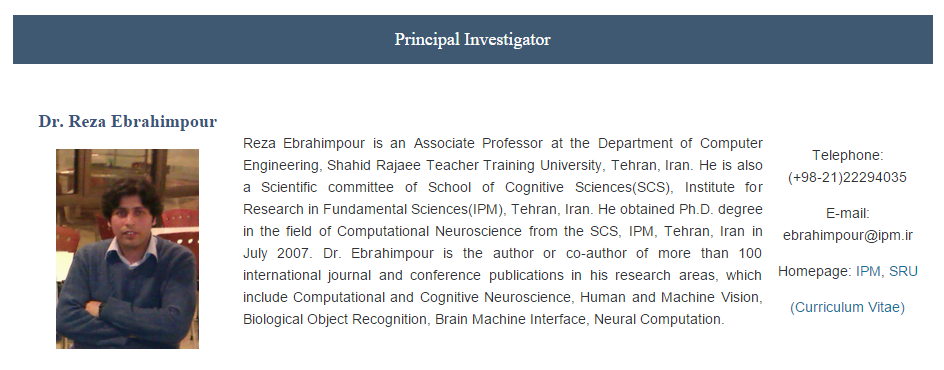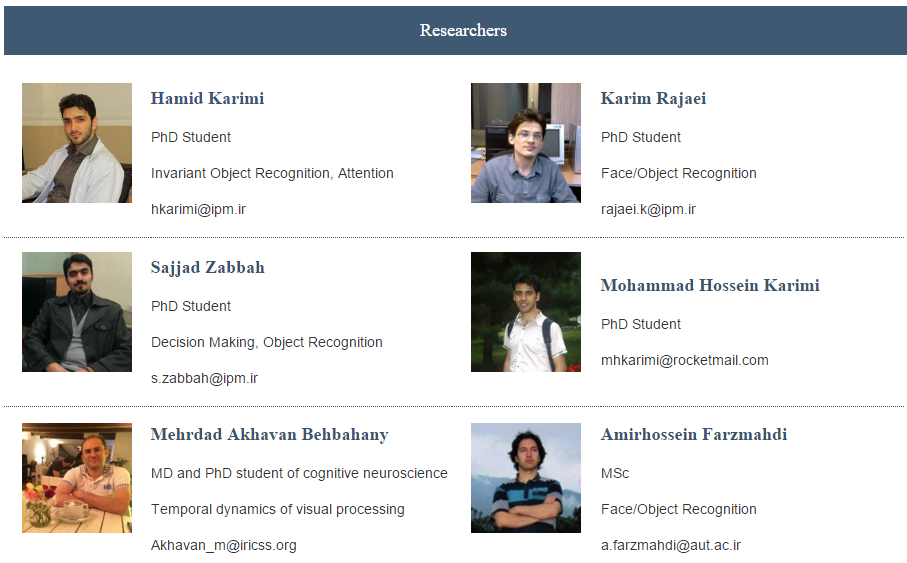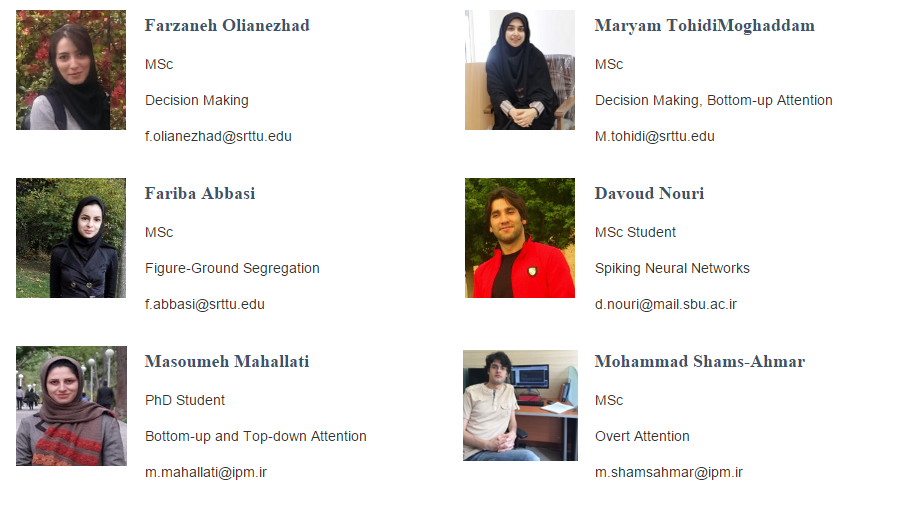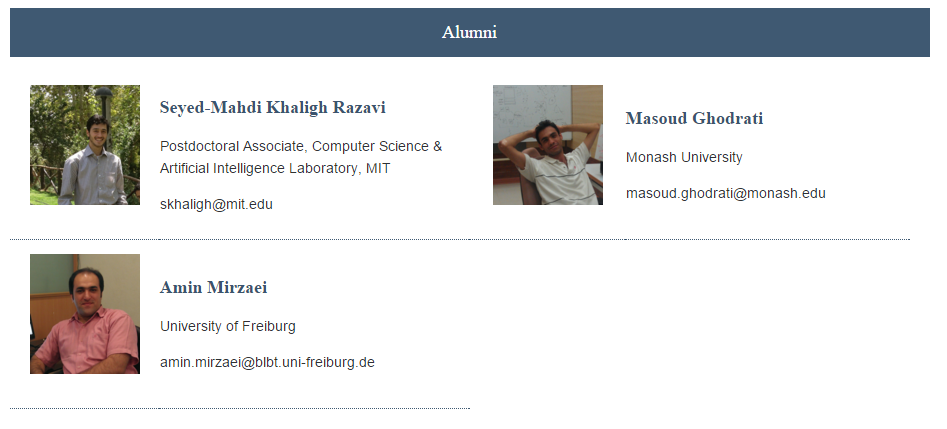

[rev_slider slider49]
RESEARCH
Research
Object/Face recognition:
We are investigating underlying mechanisms of face/object processing in the primate visual systems. We have been exploring about how the visual system recognizes different objects and trying to present a new model which is more consistent with the function of the visual system in face/object recognition. In order to achieve this goal, we are going to answer these questions: What are the cortical mechanisms underlying the different stages of the hierarchies in the visual system? What are the differences between cortical mechanisms of face and objects processing? How can visual system learn invariant representations of faces and objects? What are the temporal aspects of face processing? We are utilizing numerous methods such as computational modeling, Electroencephalography (EEG) recording, and visual psychophysics to discover the answers of these questions.
Decision making:
How we make decisions? This is our main question in this area of research. Decision making is an integrative process that results in the commitment to a categorical proposition. Determining an action based on evidences, brain should collect information from sources in different modalities. While Prior knowledge, costs and benefits of the responses get involved in the process, it should be finished in a proper time. Our research focuses on two approaches: first we probe for different aspects of decision making process with analyzing behavioral responses in psychophysics experiments. Using data from brain activities ( EEG, fMRI and cell recording), we investigate characteristics of decision process in the context of neural activities. Computational models help us to propose neural mechanism of the process. Validity of the models depends on their ability to respond for different characteristics of decision making process.
Attention:
One of significant mechanisms by the use of which our cognitive abilities are improved is attention. Top down visual attention is observed to affect neuronal response at different areas of visual cortex. This effect is seen to modulate the spike rate of neurons as well as their gamma-band LFP power, local gamma-band coherence, low frequency synchrony, correlated noise at low frequencies, receptive field and Fano factor. These modulations are detectable when recording from neurons under different experimental conditions, i.e. overt and covert attention tasks. Using data analysis, computational and statistical methods, we try to decode neural recordings to come up with underlying models and strategies involved when attention is employed in cognitive tasks. This will, in turn, pave the way for understanding other neural mechanisms involved in cognition. One of the running projects in our lab is focused on the effects of attention in improved cognition.
SELECTED PUBLICATIONS
Selected Publications
۲۰۱۴
- Saeed Reza Kheradpisheh, Abbas Nowzari-Dalini, Reza Ebrahimpour, Mohammad Ganjtabesh (January, 2014) An Evidence-Based Combining Classifier for Brain Signal Analysis, PLoS ONE, Vol. 9, No. 1, e84341. doi:10.1371/journal.pone.008434
- Masoud Ghodrati, Amirhossein Farzmahdi, Karim Rajaei, Reza Ebrahimpour, Seyed-Mahdi Khaligh-Razavi (July, 2014) Feedforward object-vision models only tolerate small image variations compared to human, Frontiers in Computational Neuroscience, Vol. 8, Article. 74, pp.1-17.
- Sajjad Zabbah, Karim Rajaei, Amin Mirzaei, Reza Ebrahimpour, Seyed-Mahdi Khaligh-Razavi (August, 2014) The impact of the lateral geniculate nucleus and corticogeniculate interactions on efficient coding and higher-order visual object processing, Vision Research, Vol. 101, pp. 82-93.
- Masoud Ghodrati, Karim Rajaee, Reza ebrahimpour (August, 2014) The Importance of Visual Features in Generic versus Specialized Object Recognition: A Computational Study, Frontiers in Computational Neuroscience, Vol. 8, Article. 78, pp.1-16.
۲۰۱۳
- Amir Ahangi, Mehdi Karamnejad, Nima Mohammadi, Reza Ebrahimpour, Nasoor Bagheri (October, 2013) Multiple classifier system for EEG signal classification with application to brain-computer interfaces, Neural Computing and Applications, Vol. 23, No. 5, pp. 1319-1327
- Amin Mirzaei, Seyed-Mahdi Khaligh-Razavi, Masoud Ghodrati, Sajjad Zabbah, Reza Ebrahimpour (April 2013) Predicting the Human Reaction Time Based on Natural Image Statistics in a RapidCategorization Task, Vision Research, Vol. 81, pp. 36–۴۴٫
- Mina Mirnaziri, Masoomeh Rahimi, Sepidehsadat Alavikakhaki, Reza Ebrahimpour (March, 2013) Using Combination of μ,β and γ Bands in Classification of EEG Signals, Basic and Clinical Neuroscience, Vol. 4, No. 1, pp. 76-87.
۲۰۱۲
- Karim Rajaei, Seyed-Mahdi Khaligh-Razavi, Masoud Ghodrati, Reza Ebrahimpour, Mohammad Ebrahim Shiri Ahmad Abadi (June, 2012). A Stable Biologically Motivated Learning Mechanism for Visual Feature Extraction to Handle Facial Categorization, PLoS ONE 7(6):e38478. doi:10.1371/journal.pone.0038478
- Reza Ebrahimpour, Atena Sajedin, Seyed Zeinolabedin Moussavi and AbbasAli Gholamhoseini Fariz hendi (May, 2012) A Bio-Inspired Computational Neural Model for Illustration Face and Car Expertise Effect on the Gateway to the Right FFA, International Journal of Innovative Computing, Information and Control(IJICIC), Volume 8, Number 5(B), pp. 3451-3466.
- Masoud Ghodrati, Seyed-Mahdi Khaligh-Razavi, Reza Ebrahimpour, Karim Rajaei, Mohammad Pooyan (February 2012) How Can Selection of Biologically Inspired Features Improve the Performance of a Robust Object Recognition Model, PLoS ONE, 7: e32357. doi:10.1371/journal.pone.0032357
COLLABORATORS
Current and former collaborators
Seyed-Mahdi Khaligh-Razavi |
Postdoctoral Associate, Computer Science & Artificial Intelligence Laboratory, MIT, USA |
Behrad Noudoost |
Department of Cell Biology and Neuroscience, Montana State University, USA |
Mohammad R.N. Avanaki |
Department of Biomedical Engineering and School of Medicine, Wayne state university, USA |






